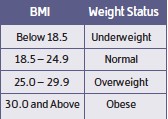Body Mass Index (BMI)

The Body Mass Index (BMI) is a quick, easy and efficient screening tool to identify weight problems in adults. While BMI is a strong indicator of body fat percentage, it can vary for age, race and sex. It is important to note that the BMI should only be utilized as a screening tool and is not, in and of itself, diagnostic. For example, older people tend to have more body fat that those who are younger, and women tend to have more body fat than men. Also, some athletes may score a higher BMI because they have increased muscle mass; therefore, they weigh more because the weight is muscle not fat. In fact, some patients notice when they combine diet and exercise, they may go down a clothing size while their weight remains the same. Overall, learning your BMI is a great starting point for a discussion of your health goals with your physician.
How is BMI determined? Body Mass Index calculates a person’s fat level by using a complex mathematical formula based an individual’s height and weight. Automatic calculators can be found online at http://www.cdc.gov/healthyweight/assessing/bmi/adult_bmi/english_bmi_calculator/bmi_calculator.html.

The chart to the right, created with information provided by the Centers for Disease Control, highlights BMI scores and their correlating weight status.
Once it is determined that you have a weight problem through this calculation, follow up with appropriate assessments for specific health risks that may be associated with a BMI of “underweight,” “overweight” or “obese” is recommended.
Body weight is only one indicator of disease risk. Combined with a high BMI, the following factors can place you at an even greater risk for certain diseases:
- High blood pressure (hypertension)
- High LDL cholesterol (“bad” cholesterol)
- Low HDL cholesterol (“good” cholesterol)
- High triglycerides
- High blood glucose (sugar)
- Family history of premature heart disease
- Physical inactivity
- Cigarette smoking
In conjunction with BMI numbers, a person’s waist circumference is also an effective way to assess weight and health risk. People who carry most of their fat around their waist, an appleshaped body, are at greater risk for type 2 diabetes and heart disease. The risk increases with a waist size that is more than 35 inches for women and greater than 40 inches for men. Scientific evidence shows that when people carry weight around their waistline, abdominal fat tends to surround internal organs, impairing their function. Conversely, people who carry their weight around their hips, a “pear shaped” body, accumulate fat directly under the skin, and thus the fat does not interfere with their organ function.
Just as a BMI over 25 can have negative health implications, so too can a BMI of 18.5 or lower, categorized as “underweight” for an adult. A BMI this low could indicate a variety of medical conditions. People with underweight body mass indexes are at increased risk for poor bone health, such as osteoporosis. Younger women classified as underweight may have disruptions of their menstrual cycle and difficulty getting pregnant. Other issues from being underweight can include anemia or a weakened immune system.
Together we can discuss appropriate options for diet and exercise that are tailored for you, and that will put you on the path of minimizing your future health risks. Learning your BMI is a great step in this direction.

